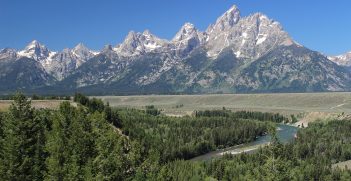The German Constitutional Court and the Future of Central Banking

Quantitative easing has long been a critical means of responding to economic crisis. In May, Germany’s Constitutional Court declared the European Central Bank’s quantitative easing program was illegal.
The claimants in the case against the European Central Bank (ECB) were a group of 1750 lawyers, economists, and other academics, including a former leader of Germany’s far-right party, Alternative for Germany (AFD). The AFD may now be famous for its torch-lit neo-Nazi processions, but it was originally founded to protest bailouts for Southern European countries during the 2012 European debt crisis.
The ECBs quantitative easing (QE) program has bought trillions of Euros of debt since 2014. The ruling concerns just one of its components, the innocuous-sounding Public Sector Purchase Programme (PSPP). The PSPP, which focuses on buying the debt of EU member states, has bought more than €2 trillion over this period. Responsible for keeping Europe out of a depression, the court’s decision threw the future of the bond buying program into doubt.
The logic of QE is simple and the same the world over. Central banks buy bonds, increase their price, lower their yield (return), and shift investors to other assets. This “portfolio rebalancing effect” assumes that the sellers, usually large financial institutions, will take the cash and put it elsewhere in the economy – for example, instead of holding safe government bonds, invest in a factory. Guided by this logic, central banks across the developed world have bought more than US$10 trillion in government and corporate bonds since the crisis.
QE and the Eurozone
While QE may be standard practice at most central banks today, it has always been fiercely controversial in the EU. The US Federal Reserve first adopted QE in late 2008, with the Bank of England joining a year later. The ECB delayed starting its QE program until late 2014. In between then, it did everything possible to avoid beginning QE.
The source of this controversy is found at the faultline between fiscal and monetary policy. Briefly, fiscal policy involves borrowing, taxation, and spending. It covers the most familiar aspects of government policy, such as building schools or giving tax breaks. Monetary policy adjusts the supply of money, which affects inflation and the exchange rate, using tools like the interest rate. Historically governments used both fiscal and monetary policy interchangeably, but after the experience of high inflation in the 1970s, a consensus emerged that they should be separated. Monetary policy was entrusted to central banks that would focus on inflation and be independent from government fiscal priorities. In practice, this meant that interest rates would be set to guarantee low inflation, not to support short-term growth or government spending.
This separation of monetary and fiscal policy is built into the economic architecture of the European Union. The 19 countries of the Eurozone share a single monetary policy, with one currency and one central bank. While the interest rate in Athens is the same as in Berlin, fiscal policy is still fiercely national. There is no collective borrowing, taxing, or spending. The EU’s founding treaty forbids bailouts where one member state takes on the debts of another. The ECB is forbidden from crossing the line into fiscal territory by financing or supporting the spending of member states, for example by buying their bonds.
It is this separation between fiscal and monetary policy, that distinguishes the European Union as we know it from the hypothetical “United States of Europe” that some have dreamt of. Collective borrowing and taxation would require collective political representation, and there has never been an appetite for a full political union. Separating fiscal and monetary policy maintains a space for national sovereignty.
Strict separation was also the price Germany extracted for joining the Euro. The inflation-phobic wing of German politics had always been concerned that a collective central bank would not be as strict on inflation as the German Bundesbank. Even worse, if a collective central bank made it easier for Southern European countries to spend, German Conservatives were terrified their taxpayers could end subsidising fiscal imprudence and then having to foot the bill in the face of a default.
QE and the future of Central Banking
For these Conservatives, QE has blown a €2.8 trillion hole in the firewall between fiscal and monetary policy. Instead of being a vehicle for discipline, the ECB is now rescuing countries like Spain and Italy from the consequences of irresponsible spending. They see the ECB’s negative interest rates and suppressed bond yields as a declaration of war against German banks and savers who are being punished for their thrift.
This is the historical terrain the case was fought on, and the verdict places the Constitutional Court firmly on the side of German Conservatives. The court used the fiscal and monetary policy divide established in the treaty to argue the ECB had overstepped its remit. As evidence, they pointed to all the PSPP’s non-monetary side effects, like asset bubbles, the survival of economically unviable firms, and easier borrowing conditions for member states. They accused the ECB of pursuing monetary policy “unconditionally while ignoring the economic policy effects resulting from the programme.” It now has three months to submit a defence.
To date, the consequences have been mild. The ECB mostly ignored the ruling, pointing to a 2018 ruling by the European Court of Justice that affirmed QE. The Constitutional Court claims the ECJ ruled in error. In June the ECB promised to send previously unreleased documents that show exactly the kind of discussion the court accuses the ECB of ignoring. The German government has stepped in to calm matters and stop contagion spreading to financial markets. The finance minister promises the issue will be resolved “without drama.”
From this vantage point, the decision in Karlsruhe is yet another skirmish in the chronology of self-inflicted violence running from the Maastricht treaty, through the European Debt Crisis and the Troika, to today’s uneasy compromise over the COVID-19 recovery fund. The problem with this view is that it is wrong.
What the Constitutional Court has done is expose the uncomfortable reality that fiscal and monetary policy are now blurred everywhere. QE has made central banks into the main source of economic stimulus. Its effect on asset prices benefits wealthy stock owners, while perpetually low bond yields make borrowing much easier for governments. This is the Rubicon that the court is addressing. The court asked whether the ECB today was still the same organisation laid out in the original treaties and said no.
Central banks reject this interpretation and argue that even though the tools may have changed, the underlying goal of price stability has not. This obscures the reality that maintaining price stability today means fighting deflation, not inflation. The most common monetary policy reference is hyperinflation in Weimar Germany, but Japan’s two “lost decades” of deflation would be more appropriate. Price stability before the crisis involved mechanically moving a short-term interest rate up or down in 0.25 percent increments. After 9/11, the Federal Reserve lowered rates by 1.75 percent in four instalments over three months. On March 15, in response to the Coronavirus crisis, the Federal Reserve dropped rates 1.5 percent to zero and promised to buy $700 billion in securities. Eight days later, they committed to buying whatever quantities were “needed to support the smooth functioning of markets.” People can be forgiven for asking whether something has changed.
The Global Financial Crisis and its perpetual aftermath required the mobilisation of creative and powerful monetary policy. QE was an experiment that saved the world from global depression, but an even larger crisis is looming. Governments will need all means at their disposal to tackle climate change, including monetary policy. An honest and wide-ranging conversation about fiscal and monetary policy and the institutions that deliver them is overdue and urgent.
The German Constitutional Court’s decision reminds us how easily this conversation can be hijacked. Since the Global Financial Crisis, central banks have rarely consulted others before making decisions. The Court’s verdict elevates the voices of an angry band of German fiscal conservatives. Neither situation is desirable. The reorganisation of fiscal and monetary policy should involve all of society because it affects all of society.
Lewis Jackson writes about economics and politics with a special interest in international politics and central banks. He has a Masters in Public Policy and Political Economy and worked as a management consultant for several years. You can find more of his writing here.
This article is published under a Creative Commons License and may be republished with attribution.





